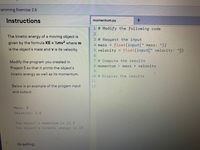
Database System Concepts
7th Edition
ISBN: 9780078022159
Author: Abraham Silberschatz Professor, Henry F. Korth, S. Sudarshan
Publisher: McGraw-Hill Education
expand_more
expand_more
format_list_bulleted
Concept explainers
Question

Transcribed Image Text:ramming Exercise 2.6
Instructions
momentum.py
1 # Modify the following code
2
The kinetic energy of a moving object is
3 # Request the input
given by the formula KE = ½mv2 where m
float(input(" mass: "))
float(input(" velocity: "))
4 mass =
is the object's mass and v is its velocity.
5 velocity =
6.
7 # Compute the results
8 momentum = mass * velocity
Modify the program you created in
Project 5 so that it prints the object's
6.
kinetic energy as well as its momentum.
10 # Display the results
11
Below is an example of the progam input
12
and output:
Mass: 5
Velocity: 2.5
The object's momentum is 12.5
The object's kinetic energy is 15
Grading
Expert Solution
arrow_forward
Given
The kinetic energy of a moving object is given by the formula KE = ½mv2 where m is the object’s mass and v is its velocity.
Modify the program you created in Project 5 so that it prints the object’s kinetic energy as well as its momentum.
Trending nowThis is a popular solution!
Step by stepSolved in 4 steps with 2 images

Knowledge Booster
Learn more about
Need a deep-dive on the concept behind this application? Look no further. Learn more about this topic, computer-science and related others by exploring similar questions and additional content below.Similar questions
- Customized step counter Learning Objectives In this lab, you will Create a function to match the specifications Use floating-point value division Instructions A pedometer treats walking 2,000 steps as walking 1 mile. It assumes that one step is a bit over 18 inches (1 mile = 36630 inches, so the pedometers assume that one step should be 18.315 inches). Let's customize this calculation to account for the size of our stride. Write a program whose input is the number of steps and the length of the step in inches, and whose output is the miles walked. Output each floating-point value with two digits after the decimal point, which can be achieved as follows: print(f'{your_value:.2f}') Ex: If the input is: 5345 18.315 the output is: You walked 5345 steps which are about 2.67 miles. Your program must define and call the following function. The function should return the number of miles walked.def steps_to_miles(user_steps, step_length) # Define your function here if __name__…arrow_forwardPlease help me to make the Flowchart and Paseudocode of my coding script below. Please! I will appriciate your help. # Program make a simple calculatorfrom itertools import permutations,combinationsimport statistics# This function adds two numbersdef add(x, y):return x + y # This function subtracts two numbersdef subtract(x, y):return x - y # This function multiplies two numbersdef multiply(x, y):return x * y # This function divides two numbersdef divide(x, y):return x / y def permutationfun(arr,length):perm = permutations(arr, length)return perm def combinationfun(arr,length):comb=combinations(arr,length)return comb def stats(marks):lengths = [x for x in marks.values()]n = len(lengths)get_sum = sum(lengths)mean = get_sum / nlengths.sort()if n % 2 == 0:median1 = lengths[n//2]median2 = lengths[n//2 - 1]median = (median1 + median2)/2else:median = lengths[n//2]data = Counter(lengths)get_mode = dict(data)mode = [k for k, v in get_mode.items() if v == max(list(data.values()))] if len(mode)…arrow_forwardTurtle Drawing with Loops Objective: To make a drawing using turtle graphics and nested loops Requirements: -Your program should ask the user at least two questions, and use the answers to help make the drawing. -Your program must have at least one pair of nested loops (a loop inside of a loop) to do some of the drawing -Your drawing cannot be made up only of rotated polygons coming from the center of the screen like we did in class. -Please write a new program for this assignment - don't use code from any in-class exercises. -For example, your program could draw a field of flowers, or you could draw a repetitive square pattern like you might see on a rug.arrow_forward
arrow_back_ios
arrow_forward_ios
Recommended textbooks for you
 Database System ConceptsComputer ScienceISBN:9780078022159Author:Abraham Silberschatz Professor, Henry F. Korth, S. SudarshanPublisher:McGraw-Hill Education
Database System ConceptsComputer ScienceISBN:9780078022159Author:Abraham Silberschatz Professor, Henry F. Korth, S. SudarshanPublisher:McGraw-Hill Education Starting Out with Python (4th Edition)Computer ScienceISBN:9780134444321Author:Tony GaddisPublisher:PEARSON
Starting Out with Python (4th Edition)Computer ScienceISBN:9780134444321Author:Tony GaddisPublisher:PEARSON Digital Fundamentals (11th Edition)Computer ScienceISBN:9780132737968Author:Thomas L. FloydPublisher:PEARSON
Digital Fundamentals (11th Edition)Computer ScienceISBN:9780132737968Author:Thomas L. FloydPublisher:PEARSON C How to Program (8th Edition)Computer ScienceISBN:9780133976892Author:Paul J. Deitel, Harvey DeitelPublisher:PEARSON
C How to Program (8th Edition)Computer ScienceISBN:9780133976892Author:Paul J. Deitel, Harvey DeitelPublisher:PEARSON Database Systems: Design, Implementation, & Manag...Computer ScienceISBN:9781337627900Author:Carlos Coronel, Steven MorrisPublisher:Cengage Learning
Database Systems: Design, Implementation, & Manag...Computer ScienceISBN:9781337627900Author:Carlos Coronel, Steven MorrisPublisher:Cengage Learning Programmable Logic ControllersComputer ScienceISBN:9780073373843Author:Frank D. PetruzellaPublisher:McGraw-Hill Education
Programmable Logic ControllersComputer ScienceISBN:9780073373843Author:Frank D. PetruzellaPublisher:McGraw-Hill Education

Database System Concepts
Computer Science
ISBN:9780078022159
Author:Abraham Silberschatz Professor, Henry F. Korth, S. Sudarshan
Publisher:McGraw-Hill Education

Starting Out with Python (4th Edition)
Computer Science
ISBN:9780134444321
Author:Tony Gaddis
Publisher:PEARSON

Digital Fundamentals (11th Edition)
Computer Science
ISBN:9780132737968
Author:Thomas L. Floyd
Publisher:PEARSON

C How to Program (8th Edition)
Computer Science
ISBN:9780133976892
Author:Paul J. Deitel, Harvey Deitel
Publisher:PEARSON

Database Systems: Design, Implementation, & Manag...
Computer Science
ISBN:9781337627900
Author:Carlos Coronel, Steven Morris
Publisher:Cengage Learning

Programmable Logic Controllers
Computer Science
ISBN:9780073373843
Author:Frank D. Petruzella
Publisher:McGraw-Hill Education